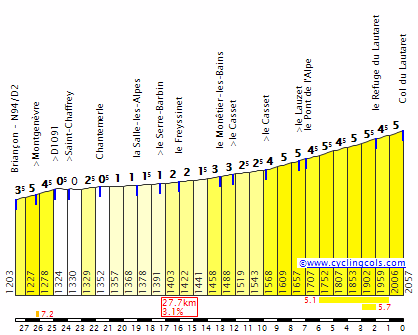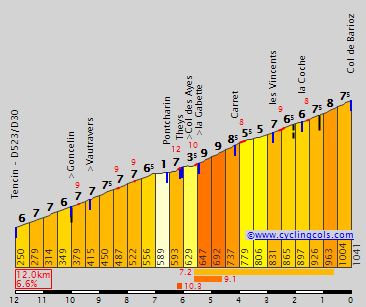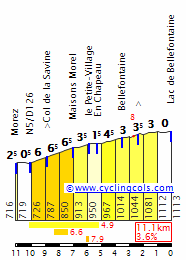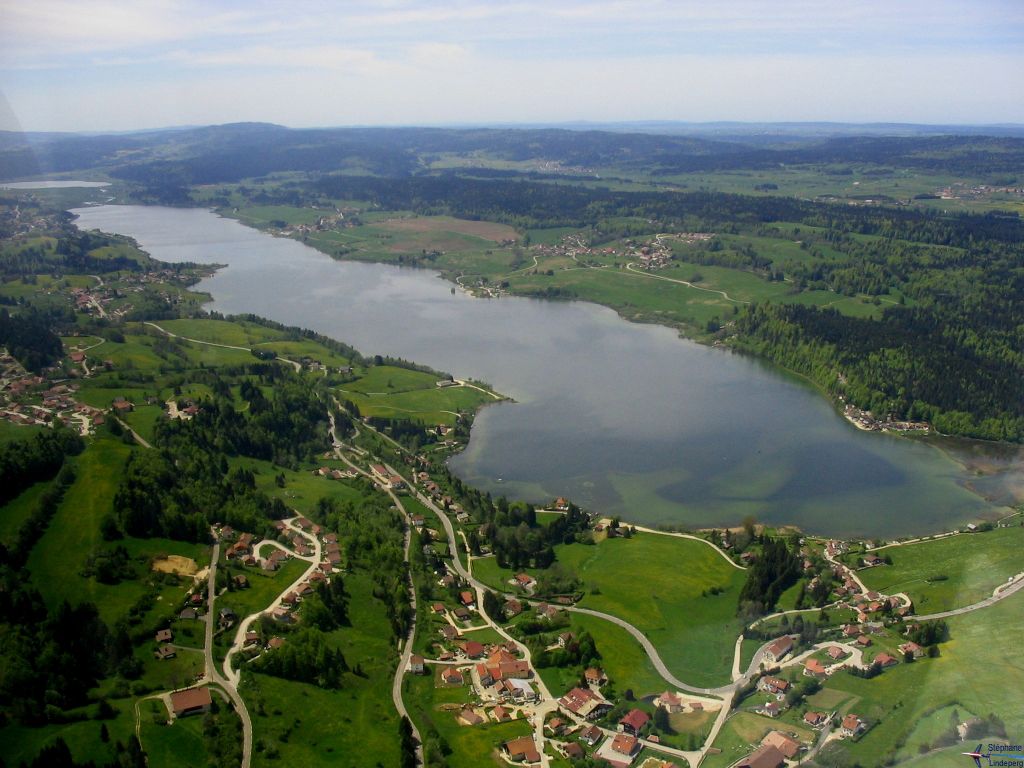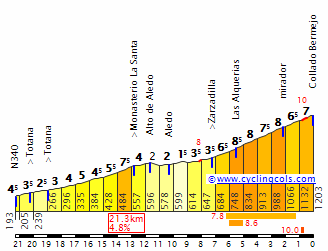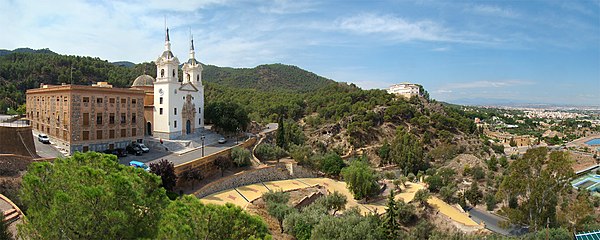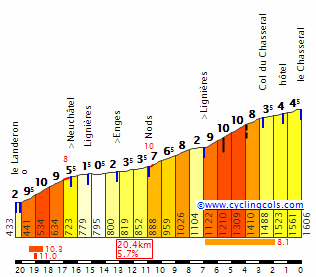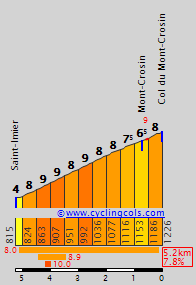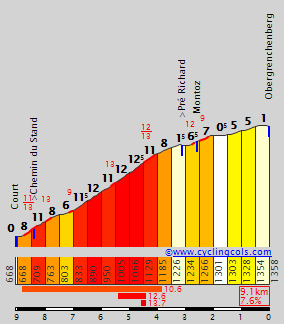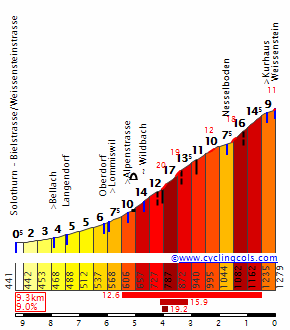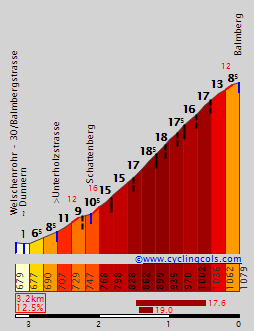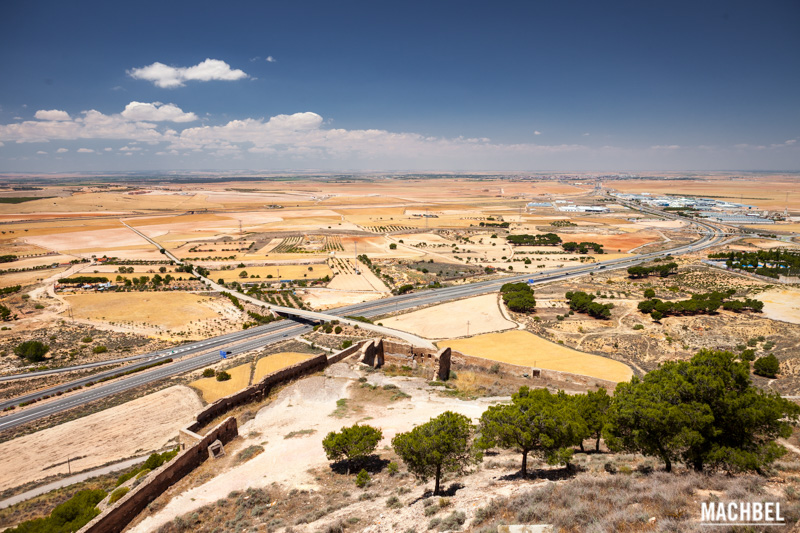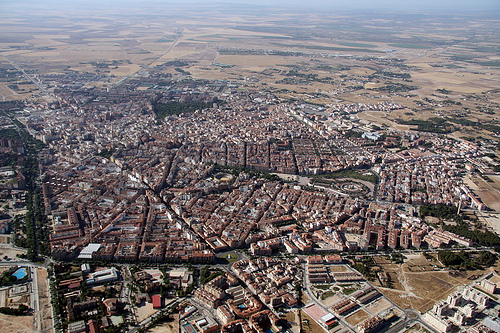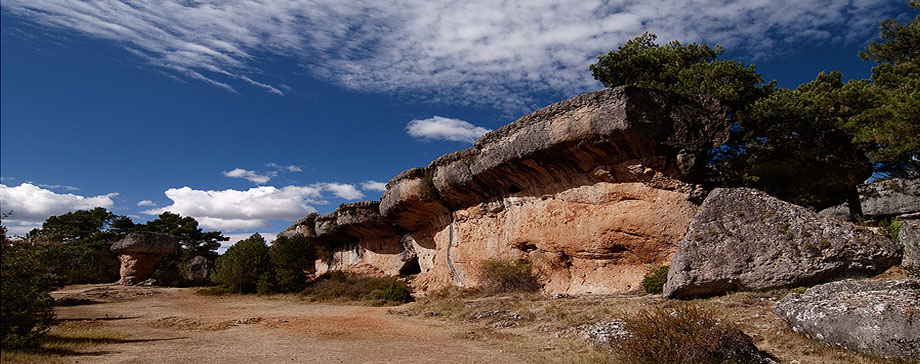The direction is similar to you, although I'm a week back in the race compared to you - transitional stage coming up.
Stage 10: Circuito de Almería - Murcia (Santuário de la Fuensanta), 215km
GPM:
Collado Bermejo (cat.1) 21,3km @ 4,8%
Alto de la Cresta del Gallo (cat.3) 5,0km @ 6,2%
Off the back of the two big mountain stages at the weekend, with the steepest finish of the race (Hazallanas) and the toughest stage of the race (Cálar Alto), there's just the one remaining obstacle for the riders before they can take a well-earned rest day. As a result, it's quite likely that this one will be disputed among the break - however not before there are some potential challenges that riders who gave their all yesterday and are struggling may find cost them crucial seconds.

Located in the hot and dry Desierto de Tabernas, not far from the town of Tabernas itself, and in the plateau to the south of the Sierra de los Filabres in which the decisive moments of yesterday's queen stage were fought, the Circuito de Almería is a motor racing facility opened in 2000 and is a tricky 4km loop which is generally used primarily for motorbike racing. Its southerly location and accessibility from much of the rest of Europe makes it a favoured testing location for motorbike racing teams, for similar reasons to that which have made the Sierra Nevada and Mallorca favoured training locations for cyclists in the off- and early-season when inclement weather makes many traditional haunts in northern and central Europe unreliable. The semi-desert terrain in the Desierto de Tabernas has also made this a favoured film location, particularly for the traditional "spaghetti westerns" where the similarity of the protected scenery to the American west before the coming of infrastructure harmed much of the pristine wilderness' suitability for the purpose led to a surge in films located in the region; some of these studios have been converted into Wild West theme parks to preserve some of that legacy.
As a result, the first hour of the race could be frenetic as riders, exhausted from mountain exploits, are suddenly required to go hard from the gun as this is one of the more intriguing challenges of the race; after the first few kilometres the shelter provided by the Sierra de los Filabres and the Sierra de Alhamilla disappears, and the riders will be in humid conditions, but also no longer protected from the Mediterranean winds, which could provide an unwelcome challenge for many of the riders as they head northeast out of Andalucía and into Murcia.

This part of the stage is flat and features a couple of locations previously used in Vueltas of mine, such as Cuevas del Almanzora, with its preserved cave dwellings overlooking the modern town, which was a stage finish for the first stage on the Iberian peninsula in the Vuelta I designed starting in Melilla, based on the 1997 national championships circuit won by José María Jiménez. For the most part though, we're not right on the coast, and some rolling hillside does offer the riders some protection, so unless the wind is particularly strong to give us echelon carnage that opens up large gaps like in the Presidential Tour of Turkey this year when on consecutive stages Caja Rural and Lotto-Soudal annihilated the field in the crosswinds, this is likely to come to naught in the long run as the riders head across the plains of inland Murcia towards the challenges of the day.
The feedzone comes in the city of Lorca, which has some cycling history. Of course, it has hosted numerous stages of the Vuelta a Murcia, but since the compression of that race into a one-day event, the small, punchy, slightly unusual (there's a tunnel with under 100m to go) climb up to the Castillo de Lorca, built by the Moors all the way back in the 13th Century, has been the site of the finish three times, being first introduced in
2013 (won by Dani Navarro), then being repeated in
2014 (won by Alejandro Valverde, the Comunidad de Murcia's most famous cyclist) and
2015 (won by Rein Taaramäe). However, in 2016 the finish of the race moved back to Murcia itself, so it remains to be seen when we will next see that little punchy finish next. The city was last seen in the Vuelta in 2010, with a
transitional flat stage won by Tyler Farrar as the race moved from Andalucía toward the north following the hilly stages to Málaga and Valdepeñas de Jaén. It is also the birthplace of 70s pro Juan Zurano, winner of several stages in small Iberian races as well as the prestigious Bilbao stage of the 1973 Vuelta, and Manuel Pascual, respected domestique of the 90s for veterans Eduardo Chozas, Asiat Saitov and José Luís Laguía in the Artiach squad until its demise in 1995.
Away from its cycling history, however, Lorca is also a very famous city, having been a former Roman city subsequently used as a frontier town between Christian and Muslim Spain during the era following Al-Andalus and the reconquista, from which the Christian Kingdom of Murcia unleashed raids on the Muslim Kingdom of Granada.

Following the feedzone, another 20km or so of flat takes us into Totana, the town at the southern edge of the Sierra de Espuña, and from which we take on our first - and most significant - climb of the day, the cat.1 grind up to the Collado Bermejo. This climb has long been the keynote ascent of the Vuelta a Murcia, with the side of the climb depending on where the finish is located. When the race was finishing in Lorca, the race climbed the opposite side, but since the restoration of the finish in Murcia itself, the riders have climbed the same side I use here, which is slightly more gradual, but only really because the flat between the first and second "steps" of the climb is slightly longer on this side. The climb has strangely never been climbed from this side in the Vuelta - and only once from the opposite side (in 2009, early in a
second week transitional stage where it was unable to have any real lasting impact other than to help David Moncoutié pad his lead in the mountains competition, and eventually the break was reeled in and Tyler Farrar won in Caravaca de la Cruz some 150km after the summit); although in fairness I have used the opposite side of the climb in one of
my Vueltas, having a mountaintop finish at the Morrón de Espuña after first climbing to Collado Bermejo then doing the climb all the way to the dead end summit of the climb.
This is a long and, as you can see, mostly quite gradual climb that steepens as it goes, with the final 7km at 7,5%, a bit like Navacerrada north in that respect, although this is a longer period of sustained climbing. The last time we saw this side of the climb in a decisive manner was in fact quite interesting, however - in the 2012 edition of the Vuelta a Murcia, the last stage race version of the event to date,
this stage saw the recently emerged Jonathan Tiernan-Locke trying to capitalize on his lightning-in-a-bottle form with promising Movistar neo-pro Nairo Quintana chasing with him, before the Colombian was able to get away from the Briton to take the stage and the lead, which he defended in the TT to win the GC. Here I don't expect it to be especially decisive, cresting just inside 70km to go, but certainly the riders who really suffered yesterday are likely not to enjoy this and it could well have a damaging effect on the breakaway, who I think will duke out the stage win here - it could be a good chance for stagehunters to rid the break of some competition or to test out how their breakmates are feeling that day. The descent is also extremely technical, so you could well see some of the less adept riders drop back in the bunch for safety on the descent, which will leave them vulnerable to any splits in the péloton from crashes, incidents, echelons or just if the pace is upped by teams at the front once they arrive at the foot of the descent in Alhama de Murcia.

Although the stage is labelled as Murcia being the stage town, we don't actually head into the city itself, instead the next 30-35km of flat see the riders along an exposed area between the Sierra de Espuña and the Sierra de Carrascoy as we head for the suburban sprawl of the city and towards the last categorized climb of the day. We are all familiar with Cresta del Gallo now; it was first introduced to the Vuelta in 1979, when the race was frantically searching for new climbs to bring prestige following the decision that the race could no longer enter the Basque Country, meaning traditional and historic climbs like Orduña, Urkiola, Jaizkibel and Herrera were now off-limits (interestingly, the same race saw the introduction of Peña Cabarga, which was then forgotten about for decades too). Juan Argudo won the stage over the climb and into Murcia, and it was successful enough to be repeated in 1981, when Basque Imanol Murga took the victory. However, with the onset of the skiing industry in the 1970s in Spain, and the bigger success of the Sierra Nevada and Catalan climbs followed by the Asturian discoveries shortly afterward, transitional stages around Murcia fell from favour until 2001, when Carlos Sastre was first over the climb only for his escape to be unsuccessful; a small group swallowed up Don Limpio and Czech Tomáš Konečný won the stage.
The ascent has become well known in recent years, however; a transitional stage
in 2009 was the first of several won by breaks allowed to go the distance by Caisse d'Epargne to protect Valverde's lead, picked up on Xorret del Catí the previous day; Linus Gerdemann was the first over the climb (ascended from its eastern face which we descend here) and comfortably on his way to the stage, but a mechanical derailed his bid for the victory, opening up the opportunity for a quartet of Alexandre Vinokourov (in his final contribution of interest in his first comeback race for Astana, having entered l'Ain with a national team), Ryder Hesjedal, Jakob Fuglsang and eventual stage winner Simon Gerrans (back in his old, interesting stagehunter phase) to sprint for the win. As the Vuelta was in its "if it works, copy it" phase, the stage was brought back in 2010, this time
climbing from the opposite side. This time, it still being in week 1 and with no substantial mountains yet scaled, the GC was much tighter, and while there were some attempts to make a difference on the climb, eventually a group trimmed to 70 fought out the win, and Thor Hushovd outsprinted Daniele Bennati and Grega Bole for the win.
Since then, the climb went unused by La Vuelta until 2015's edition, when they scaled it twice. It was a controversial stage, which you can rewatch
here. Although the controversy had little to do with the actual climb or the victory for Jasper Stuyven, who outsprinted Pello Bilbao, Kévin Reza and Giovanni Visconti from a group of 50 after the late attack from Zé Gonçalves was pulled back at the last minute; rather it was that after the péloton had split, the front group's strongest sprinting member, Peter Sagan, was isolated and at one point swinging across the road he was struck by an inattentive moto. Understandably angered, the soon-to-be World Champion flew into a fit of anger about the dangerous moto, which people mostly accepted, then threw punches and spat at the medical car, which some did and some didn't accept, in that his rage was understandable but launching it at those who were not only not responsible but were trying to help him was counterproductive at best, and childish and stupid at worst. The climb has also been used more recently, in the Vuelta a Murcia on its 2016 route, which
bears more than a passing resemblance to this stage. That stage aped the typical Vuelta stage with Cresta del Gallo and a finish in the city, however, which I do not. It is, however, our most recent guide to racing on the climb, and so you can see the highlights
here - the different race situation created by the mixed field and the one-day nature of the race led to a very selective front group of seven that contested the win, with Philippe Gilbert eventually besting local hero Alejandro Valverde in the sprint, with Ilnur Zakarin completing the podium, squeezing out another Murcian, Luís León Sánchez (who is from Cieza, in the north of the province).
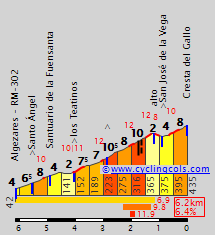
The actual climb we are using is this side of it, as far as where is marked "alto", as we then descend the San José de la Vega side that was climbed in 2009, and the ascent crests with just 9km remaining, meaning it ought to be more decisive than in those stages we've seen in recent years where it is more like 15 from the line, thus giving the bunch behind more chance of catching back on. The main reason for this, however, is that this is not a straightforward flat finish, instead we loop back to the start of the climb and do the first 1400m again, leading to a finish at the Santuário de la Fuensanta, which you can see marked on that profile. The climb to the sanctuary averages 6,0% (there's a bit of false flat not shown on that profile beforehand) but with the last 600m at 8% there is the opportunity for this to be decisive and see seconds won and lost even if Cresta del Gallo can't create them. And also, with the tired legs that the heads of state should have after two tough mountain stages in a row, and with a rest day to come tomorrow, and with Cresta del Gallo starting less than 15km from the line, there's the potential that this could be a real banana skin for the GC men - even if I expect they'll be arriving ten minutes or more behind the breakaway which will likely fall apart on Cresta del Gallo in the hunt for the stage win; the climb is too close to the line for a 2010 or 2015 situation to develop and even if we get a small group like in 2009 they still have everything to fight for in the final climb up to the Santuário de la Fuensanta.
The reason I can get away with not finishing in the city is that the rest day is held there, so here we have an archetypal Valverde finish perfectly placed for Valverde himself, on home roads. Except that he'll be very disappointed if he's in the breakaway here, of course...




